Alpha ketoglutarate - Study guides, Class notes & Summaries
Looking for the best study guides, study notes and summaries about Alpha ketoglutarate? On this page you'll find 176 study documents about Alpha ketoglutarate.
Page 2 out of 176 results
Sort by
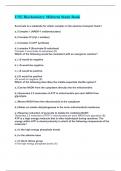
-
UNE Biochemistry Midterm Study Bank Questions and answers
- Exam (elaborations) • 20 pages • 2024
- Available in package deal
-
- $8.49
- + learn more
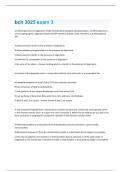
-
bch 3025 exam 3 Questions & Answers Already Passed!!
- Exam (elaborations) • 66 pages • 2024
- Available in package deal
-
- $7.99
- + learn more
2,4-Dinitrophenol and oligomycin inhibit mitochondrial oxidative phosphorylation. 2,4-Dinitrophenol is an uncoupling agent; oligomycin blocks the ATP synthesis reaction itself. Therefore, 2,4-dinitrophenol will: A) allow electron transfer in the presence of oligomycin. B) allow oxidative phosphorylation in the presence of oligomycin. C) block electron transfer in the presence of oligomycin. D) diminish O2 consumption in the presence of oligomycin E) do none of the above. - Answer-A) allow...
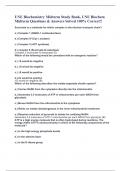
-
UNE Biochemistry Midterm Study Bank, UNE Biochem Midterm Questions & Answers Solved 100% Correct!!
- Exam (elaborations) • 28 pages • 2024
-
- $14.49
- + learn more
UNE Biochemistry Midterm Study Bank, UNE Biochem Midterm Questions & Answers Solved 100% Correct!! Succinate is a substrate for which complex in the electron transport chain? a.) Complex 1 (NADH-1 oxidoreductase) b.) Complex IV (Cyt c oxidase) c.) Complex V (ATP synthase) d.) complex II (Succinate-Q reductase) Complex II (succinate-Q reductase) (D) Which of the following would be consistent with an exergonic reaction? a.) ∆S would be negative b.) ∆G would be negative ...

-
UNE Biochemistry Midterm Study Bank, UNE Biochem Midterm Questions & Answers Solved 100% Correct!!
- Exam (elaborations) • 28 pages • 2024
- Available in package deal
-
- $8.49
- + learn more
UNE Biochemistry Midterm Study Bank, UNE Biochem Midterm Questions & Answers Solved 100% Correct!! Succinate is a substrate for which complex in the electron transport chain? a.) Complex 1 (NADH-1 oxidoreductase) b.) Complex IV (Cyt c oxidase) c.) Complex V (ATP synthase) d.) complex II (Succinate-Q reductase) Complex II (succinate-Q reductase) (D) Which of the following would be consistent with an exergonic reaction? a.) ∆S would be negative b.) ∆G would be negative...
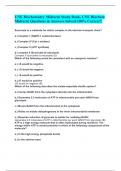
-
UNE Biochemistry Midterm Study Bank, UNE Biochem Midterm Questions & Answers Solved 100% Correct!!
- Exam (elaborations) • 28 pages • 2024
- Available in package deal
-
- $8.99
- + learn more
UNE Biochemistry Midterm Study Bank, UNE Biochem Midterm Questions & Answers Solved 100% Correct!! Succinate is a substrate for which complex in the electron transport chain? a.) Complex 1 (NADH-1 oxidoreductase) b.) Complex IV (Cyt c oxidase) c.) Complex V (ATP synthase) d.) complex II (Succinate-Q reductase) Complex II (succinate-Q reductase) (D) Which of the following would be consistent with an exergonic reaction? a.) ∆S would be negative b.) ∆G would be negative...
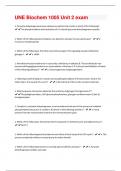
-
UNE Biochem 1005 Unit 2 Exam Questions And Answers Rated A+ New Update Assured Satisfaction
- Exam (elaborations) • 16 pages • 2024
- Available in package deal
-
- $7.99
- + learn more
1. Pyruvate dehydrogenase kinase catalyzes a reaction that results in which of the following? - The phosphorylation and inactivation of E1 subunit (pyruvate dehydrogenase complex 1. Which of the following intermediates is an allosteric activator of pyruvate kinase? -a. Fructose 1.6 bisphosphate 1. Which of the following is the initial second messenger in the signaling cascade initiated by glucagon? -a. cAMP 1. Hereditary fructose intolerance in caused by a deficiency in aldolase B. These i...

-
USMLE- BIOCHEMISTRY- EXAM 3 | WITH 100% CORRECT ANSWERS | LATEST UPDATE | GRADED A+
- Exam (elaborations) • 11 pages • 2024
- Available in package deal
-
- $8.49
- + learn more
1 Q 2. Identify the metabolite that does NOT serve as a precursor of a dietarily essential amino acid: A. Alpha-ketoglutarate B. 3-phosphoglycerate C. Glutamate D. Aspartate E. Histamine A E. Histamine Histamine is a catabolite, not a precursor, of histidine. 2 Q 4. Select the CORRECT answer: The first reaction in the degradation of most of the protein amino acids involves the participation of: A. NAD+ B. Thiamine pyrophosphate (TPP) C. Pyridoxal phosphate D. FAD E. NAD+ and TP...
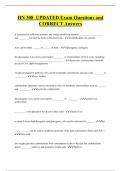
-
HN 308 UPDATED Exam Questions and CORRECT Answers
- Exam (elaborations) • 9 pages • 2024
- Available in package deal
-
- $7.99
- + learn more
if consumed in sufficient amounts, any energy producing nutrient ________, __________, and ________ can fuel the body in the short term - carbohydrate; fat; protein AAs can be either ______ or ______ or both. - glucogenic; ketogenic the glucogenic AAs can be converted to ________ or intermediates of TCA cycle, including _________, ________, ___________, _________ - pyruvate; oxaloacetate, fumarate, succinyl CoA, alpha-ketoglutarate via gluconeogenesis pathway, AAs can be eventually conv...
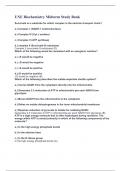
-
UNE Biochemistry Midterm Study Bank
- Exam (elaborations) • 20 pages • 2024
-
- $16.49
- + learn more
UNE Biochemistry Midterm Study Bank Succinate is a substrate for which complex in the electron transport chain? a.) Complex 1 (NADH-1 oxidoreductase) b.) Complex IV (Cyt c oxidase) c.) Complex V (ATP synthase) d.) complex II (Succinate-Q reductase) Complex II (succinate-Q reductase) (D) Which of the following would be consistent with an exergonic reaction? a.) ∆S would be negative b.) ∆G would be negative c.) ∆S would be positive d.)∆G would be positive ∆G...

-
UNE Biochemistry Midterm Study Bank
- Exam (elaborations) • 20 pages • 2024
-
- $15.99
- + learn more
UNE Biochemistry Midterm Study Bank Succinate is a substrate for which complex in the electron transport chain? a.) Complex 1 (NADH-1 oxidoreductase) b.) Complex IV (Cyt c oxidase) c.) Complex V (ATP synthase) d.) complex II (Succinate-Q reductase) Complex II (succinate-Q reductase) (D) Which of the following would be consistent with an exergonic reaction? a.) ∆S would be negative b.) ∆G would be negative c.) ∆S would be positive d.)∆G would be positive ∆G...

That summary you just bought made someone very happy. Also get paid weekly? Sell your study resources on Stuvia! Discover all about earning on Stuvia


